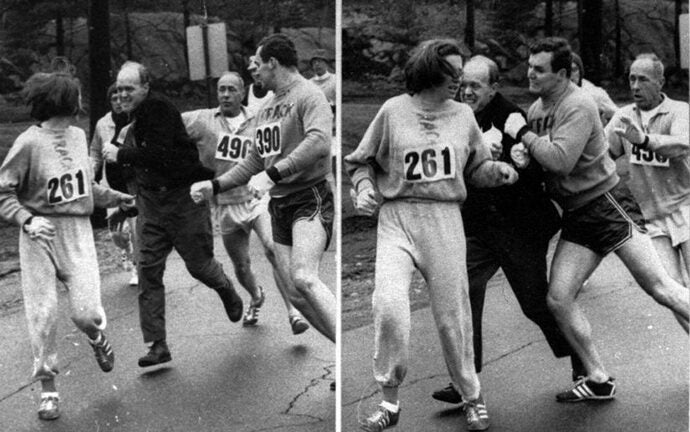
A new form of sexism? Now TV coverage of women’s sports is just plain boring
When tennis great John McEnroe recently claimed that women’s champion Serena Williams wouldn’t even be a “top 700” men’s player, his controversial comment made headlines on sports shows and beyond.
It was just one more example of how hard it continues to be for women’s sports to receive any attention at all, unless it is somehow filtered through a dismissive male gaze.
While mainstream broadcast coverage now treats the games women play a bit more seriously, much of that now mostly respectful coverage is still being relegated to the sidelines, according to an ongoing, decades-long study by USC researchers that was published Sept. 12 in the journal Gender & Society.
Led by Michael Messner, professor of sociology and gender studies at USC Dornsife, the research team found that Los Angeles-based network affiliates devoted 3.2 percent of airtime to women’s sports on news broadcasts, down from 5 percent in 1989, the first year of the study. ESPN’s SportsCenter has been even worse, devoting 2 percent of airtime to women’s sports, a proportion that has remained flat since the study began tracking the show in 1999.
“When compared to the start of the study, women used to be framed in ways that were overtly sexist. Now the sexism is subtler,” said study lead author Michela Musto, a doctoral student in sociology and gender studies at USC Dornsife. “It seems at first that it’s respectful, but if you compare the framing with men’s sports, women are talked about in a much more boring way. There is no joking or complimenting. Those kinds of descriptors are missing from women’s sports.”
The researchers have regularly updated their findings roughly every five years, in 1993, 1999, 2004, 2009 and 2014. They plan to start research again later this year for an update in 2018.
Still ignored, even as female participation surges

Professor of Sociology and Gender Studies Michael Messner. Photo by Emily Cavalcanti.
In replicating previous cycles of the study, the researchers analyzed three two-week segments (a total of six weeks) of televised sports news coverage on three L.A. network affiliates, and did the same on ESPN’s SportsCenter. They then coded the coverage across 20 distinct categories, including gender, type of sport, competitive level of sport, segment length and production value.
Much of the overall disparity may also be due to the little airtime devoted to each individual woman’s story on SportsCenter: Women’s stories averaged 77 seconds, nearly 50 percent shorter than men’s stories, though still better than the 44 seconds given to women’s stories on local affiliates.
Even off-season coverage of men’s sports received more airtime than in-season women’s coverage.
Such overall respectful coverage may be progress from the time when Morganna the Kissing Bandit — a female entertainer famous from the ’70s through the ’90s for running on to the field to kiss baseball players during games — was one of the few women featured on the local sports report. However, even the improved tone of this coverage carried its own brand of chauvinism, or what the researchers termed “gender bland” — programming that is treated as a sort of mandatory and perfunctory “set aside.”
The researchers said that in this “gender-bland” programming, women’s athletic achievements are portrayed as “lackluster” and “uninspired.” That is, unless they are depicted as caring teammates or partners and spouses, such as 2016 Olympic trap-shooter medalist Corey Cogdell-Unrein’s portrayal in mainstream media as “the wife of a Chicago Bears linebacker.”
The researchers noted that the sparse coverage of women’s sports is out of step with another simultaneous trend: a surge of female athletes since the 1970s, when Title IX became law, prohibiting discrimination on the basis of sex in education for athletics and other programs that receive federal funds.
About 45 years ago, less than 300,000 girls played high school sports and fewer than 30,000 played in college. Today, more than 3 million girls participate in high school sports, compared to 4.4 million boys. According to data from the National Collegiate Athletic Association, in 2014, the gender ratio for its almost half a million student-athletes was even closer: about 44 percent female to 56 percent male.
The allegory of the ‘man cave’
There are few women in sports media roles that may influence coverage decisions, the researchers noted. They found that 95 percent of the anchors, co-anchors and analysts covered by their research were male. The data is consistent with other findings that 90.1 percent of sports print editors are male.
When a woman in the sports broadcast industry moves upward, as sideline reporter Samantha Ponder did this August when she replaced Chris Berman as host of ESPN’s featured NFL program, Sunday NFL Countdown, it still makes big news.
“I do believe that part of the move toward greater respect and equity for women’s sports in the media will involve getting more women into newspaper sports desks, radio and TV commentary,” said senior author Messner. “However, I also think that employers, when they hire new people, should seek to hire reporters and commentators — women or men — who really care about women’s sports, who can and will express genuine enthusiasm, rather than gender-bland sexism, when they report on women’s sports.”
Messner has helped lead the study since its inception in 1989. In response to the study’s results in 2010, ESPN announced a new ESPNW brand channel to better cover women’s sports. The network even proposed that it might one day become its own stand-alone cable television channel. Such a channel still has yet to exist.
“Though the father network is not gender-marked with an ‘M,’ it remains a kind of electronic man cave, by, for and about men’s sports,” Messner said.
About the study
The study was conducted by Messner and Musto with Cheryl Cooky of Purdue University. The research was funded primarily through a grant from the University of Michigan’s Sport, Health and Activity Research and Policy Center, with supplemental support from USC’s Center for Feminist Research, the USC Annenberg School for Communication and Journalism and the Purdue Office of the Provost.